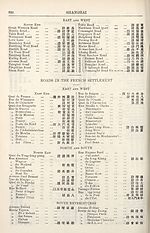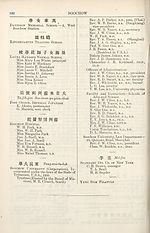1918
(907) [Page 831] - Soochow
Download files
Complete book:
Individual page:
Thumbnail gallery: Grid view | List view
![(907) [Page 831] - Soochow](https://deriv.nls.uk/dcn17/1949/0512/194905123.17.jpg)
SOOCHOW
M S Su-chau
Soochow,the capital of the province of Kiangsu, lies about eighty miles west by water
and fifty-four by railand alittle north of Shanghai, with which it is connected by excellent
inland water-ways. The Shanghai-Nanking Railway supplies still better connection.
The city is a rectangle, its length from north to south being three and a half miles and its
width from east to west two and a half, the total circumference being about 10 miles. It
lies not far from the eastern shore of the great Taihu lake. Past its walls runs the
southern section of the Grand Canal, which joins Hangchow to Chinkiang; and in every
direction spread creeks or canals, affording easy communication with the numerous
towns in the surrounding country. It is an important manufacturing cen tre, with a
population of over half a million. Its two chief manufactures are satins and silk
embroideries of various kinds. In addition, it sends out silk goods, linen and cotton
fabrics, paper, lacquerware, and articles in iron, ivory, wood, horn, and glass.
Since the opening of the port manufactures on foreign principles have been introduced,
and there are now three silk filatures and one cotton mill. Before the Taiping rebellion
Soochow shared with Hangchow the reputation of being the finest city in China, but
it was almost entirely destroyed by the rebels, who captured it on'25th May, 1860. Its
recovery by Major (afterwards General) Gordon on 27th Nov., 1863, was the first
effective blow to the rebellion. Since that disastrous period it has recovered itself
greatly and is once more populous and flourishing, though it has not yet attained to
its former pitch of prosperity. It was declared open to foreign trade on the 26th
September, 1896, under the provisions of the Japanese Treaty. The Foreign Settlement
is under the southern wall of the city, just across the Canal, and is a strip of land
about 1J miles long and a quarter of a mile broad. The western portion has been
reserved for a Japanese Settlement. The government has made a good carriage road
along the Canal bank extending the whole length of the settlement, and as far as the
railway station, a distance of five and a half miles, on which carriages and ricshas ply,
and on fine days the road is crowded with people from the city, amusing themselves,
walking and driving. The Chinese and European school was opened in 1900. The gross
value of the trade of the port passing through the Maritime Customs in 1916 was Hk.
Tls. 16,767,823 as compared with Hk. Tls. 15,934,436 in 1915 and the previous record
total of Hk. Tis. 16,311,166 in 1913. But this represent^ only a small portion of the
total trade of the port, a quantity of which does not come under the jurisdiction of the
Customs.
DIRECTORY
i3 A-si-a
Asiatic Petroleum Co. (North China),
Ltd., Tel. Ad: Doric
H. G. Curran, manager
G. H. Sutcliffe
British American Tobacco Co.
China Mutual Life Insurance Co.
C. A. da Costa, agency manager
Ja $ as B E # +
Chinese Post Office
First Class Postmaster—S. J. Harris
Consulate, Japanese
Consul in charge—R. Ikenaga
m m nm Soo-chow Hein-kuan
Customs, Chinese Maritime
Commissioner—R. Kurosawa
Assts.—R. A. May, Henry Wong
Med. Officers —J. A. Snell, W. B.
Russell
Tidesurveyor—B. Pedersen (acting)
Examiner—J. C. Power, K. Kikuchi
Tide waiters—M. G. Yierna, E. A.
Weekes, S. Rokugo
Kiangsu Likin Collectorate
Commissioner—R. Kurosawa
M S Su-chau
Soochow,the capital of the province of Kiangsu, lies about eighty miles west by water
and fifty-four by railand alittle north of Shanghai, with which it is connected by excellent
inland water-ways. The Shanghai-Nanking Railway supplies still better connection.
The city is a rectangle, its length from north to south being three and a half miles and its
width from east to west two and a half, the total circumference being about 10 miles. It
lies not far from the eastern shore of the great Taihu lake. Past its walls runs the
southern section of the Grand Canal, which joins Hangchow to Chinkiang; and in every
direction spread creeks or canals, affording easy communication with the numerous
towns in the surrounding country. It is an important manufacturing cen tre, with a
population of over half a million. Its two chief manufactures are satins and silk
embroideries of various kinds. In addition, it sends out silk goods, linen and cotton
fabrics, paper, lacquerware, and articles in iron, ivory, wood, horn, and glass.
Since the opening of the port manufactures on foreign principles have been introduced,
and there are now three silk filatures and one cotton mill. Before the Taiping rebellion
Soochow shared with Hangchow the reputation of being the finest city in China, but
it was almost entirely destroyed by the rebels, who captured it on'25th May, 1860. Its
recovery by Major (afterwards General) Gordon on 27th Nov., 1863, was the first
effective blow to the rebellion. Since that disastrous period it has recovered itself
greatly and is once more populous and flourishing, though it has not yet attained to
its former pitch of prosperity. It was declared open to foreign trade on the 26th
September, 1896, under the provisions of the Japanese Treaty. The Foreign Settlement
is under the southern wall of the city, just across the Canal, and is a strip of land
about 1J miles long and a quarter of a mile broad. The western portion has been
reserved for a Japanese Settlement. The government has made a good carriage road
along the Canal bank extending the whole length of the settlement, and as far as the
railway station, a distance of five and a half miles, on which carriages and ricshas ply,
and on fine days the road is crowded with people from the city, amusing themselves,
walking and driving. The Chinese and European school was opened in 1900. The gross
value of the trade of the port passing through the Maritime Customs in 1916 was Hk.
Tls. 16,767,823 as compared with Hk. Tls. 15,934,436 in 1915 and the previous record
total of Hk. Tis. 16,311,166 in 1913. But this represent^ only a small portion of the
total trade of the port, a quantity of which does not come under the jurisdiction of the
Customs.
DIRECTORY
i3 A-si-a
Asiatic Petroleum Co. (North China),
Ltd., Tel. Ad: Doric
H. G. Curran, manager
G. H. Sutcliffe
British American Tobacco Co.
China Mutual Life Insurance Co.
C. A. da Costa, agency manager
Ja $ as B E # +
Chinese Post Office
First Class Postmaster—S. J. Harris
Consulate, Japanese
Consul in charge—R. Ikenaga
m m nm Soo-chow Hein-kuan
Customs, Chinese Maritime
Commissioner—R. Kurosawa
Assts.—R. A. May, Henry Wong
Med. Officers —J. A. Snell, W. B.
Russell
Tidesurveyor—B. Pedersen (acting)
Examiner—J. C. Power, K. Kikuchi
Tide waiters—M. G. Yierna, E. A.
Weekes, S. Rokugo
Kiangsu Likin Collectorate
Commissioner—R. Kurosawa
Set display mode to:
![]() Universal Viewer |
Universal Viewer | ![]() Mirador |
Large image | Transcription
Mirador |
Large image | Transcription
Images and transcriptions on this page, including medium image downloads, may be used under the Creative Commons Attribution 4.0 International Licence unless otherwise stated. ![]()
| Asian directories and chronicles > 1918 > (907) [Page 831] - Soochow |
|---|
| Permanent URL | https://digital.nls.uk/194905121 |
|---|
| Attribution and copyright: |
|
|---|---|
| Description | Volumes from the Asian 'Directory and Chronicle' series covering 1917-1941, but missing 1919 and 1923. Compiled annually from a multiplicity of local sources and research. They provide listings of each country's active corporations, foreign residents and government agencies of all nationalities for that year, together with their addresses. Content includes: various treaties; coverage of conflicts; currencies and taxes; consular fees; weights and measures; public holidays; festivals and traditions. A source of information for both Western states and communities of foreigners living in Asia. Published by Hongkong Daily Press. |
|---|---|
| Shelfmark | H3.86.1303 |
| Additional NLS resources: |

